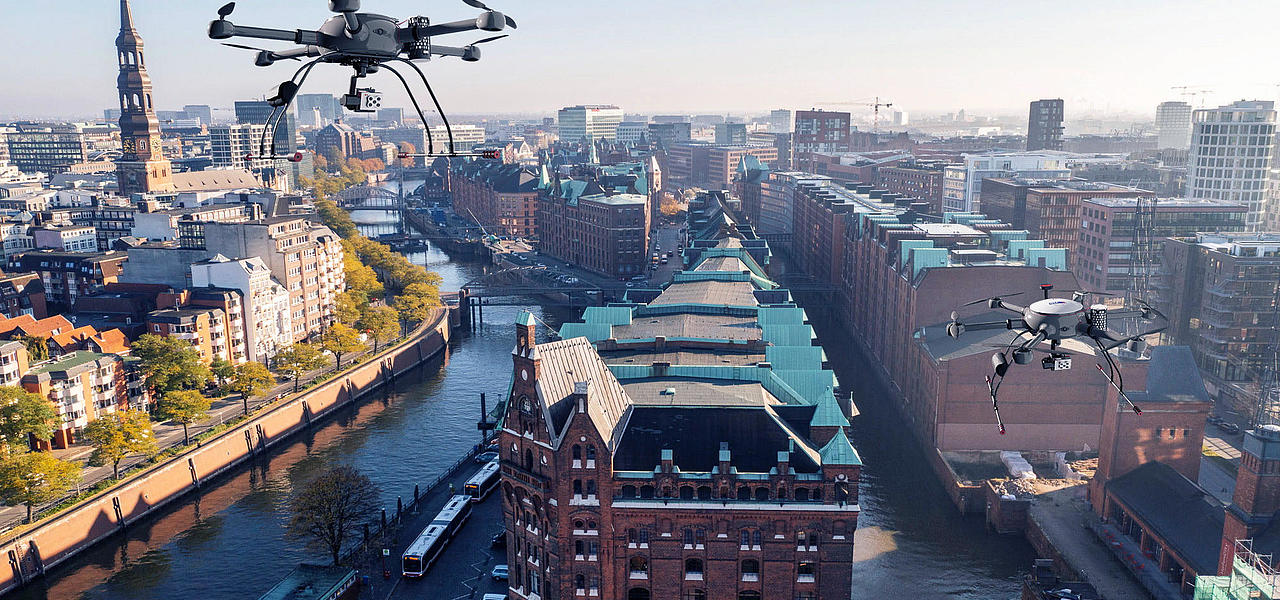Innovative Logistics Solutions
HHLA is more than just a transport and logistics company: we are driving forward the digitalisation of logistics and optimising supply chains with our pioneering innovations. Only with system innovations can we overcome major challenges such as geopolitical crises, complex supply chains and the growing demand for climate-friendly processes.
Logistics 4.0 for the Entire Industry
At HHLA, we rely on digital solutions and promote their development with our innovation unit HHLA Next. Our goal is to accelerate processes, create a competitive advantage for our customers and make the supply chain more resilient, efficient and sustainable. We offer our customers and partners easy access to our services through innovative data networks and platforms.

A key factor for successful digital networking is the linking of existing logistics systems. There are currently a large number of different systems on the market, which makes ‘digitisation on the quayside’ more difficult. To enable better digital networking, we are working on developing an open, cross-system data network and collaborative digital platforms for transport data.
A Europe-wide network that makes all data accessible along the entire logistics chain is essential to making the transport industry more efficient and sustainable. Our goal is to create standardised and cross-system interfaces that benefit the entire industry.

We are actively seeking digital solutions for Logistics 4.0 and are driving them forward with HHLA Next. Our venture-building and investment unit combines our many years of expertise with the agility of a start-up. This is where ideas are turned into smart products and new business models for the future of logistics – as in-house developments, in cooperation with partners or through investments in innovative companies. To do this, we continuously monitor and analyse market trends and new technologies worldwide, and assign them to strategic fields of innovation and specific use cases in the logistics industry. This enables us to approach promising companies at an early stage or develop our own products.
As a holding company, HHLA Next also provides the necessary framework, structures and processes for spin-offs and investments. It supports existing portfolio companies, for example in market research and strategic decisions. After all, they all pursue the same goal: to optimise processes through automation and digitalisation. This is how we create competitive advantages for our customers and make supply chains more resilient, efficient and sustainable.
Digital Truck Clearance With passify
Every day, more than 6,000 trucks travel to and from our Hamburg terminals to deliver or pick up containers. Until now, truck drivers have accessed the terminals using their own plastic trucker card. To make gate access management at our terminals even more efficient and secure, we have now replaced the traditional trucker card with the digital solution passify – a spin-off from our innovation unit HHLA Next.
Secure
Maximum security in line with the highest international ISPS standard through digital driver authenticationEfficient
Full integration into gate processes and terminal operationsDigital
Registration and access to the terminal via smartphone appThe smartphone app is seamlessly integrated into the terminal processes and guides truck drivers through the entire check-in process at the port. Multi-factor authentication facilitates and secures access to terminals and depots: only authorised truck drivers are granted access, reducing the risk of unauthorised access and optimising the entry and exit process. A particular advantage of passify is that companies can install the app directly on their drivers' mobile devices, making it easy to implement. In the future, passify will offer additional features, such as a link to TMS systems, which will enable better planning for all parties involved.

Drones offer much more than just fast deliveries. As versatile universal tools, they perform important tasks from the air, such as reconnaissance and surveillance for the fire brigade, disaster relief or airports. In logistics, they not only act as fast couriers, but also carry out automated stock-taking in warehouses, inspect damage to transport infrastructures and deliver materials and spare parts for machines, which considerably simplifies production logistics. In this way, drones play a significant role in making processes more efficient and cost-effective.

HHLA Sky Integrated Drone Control Centre
HHLA Sky has recognised this trend early on and developed highly robust and secure industrial drones. However, to enable drones to reach their full potential in logistics, it is not enough just to automate the flights – the entire process chain must be optimised. That is why HHLA Sky has developed the world's first scalable drone control centre (Integrated Control Center, ICC). This system makes it possible to simultaneously and autonomously control and coordinate drone fleets and robots on the ground – such as automated guided vehicles (AGVs) – at various locations worldwide, and in real time.

FERNRIDE, the leading platform for autonomous, electric trucking, in which HHLA Next is involved, equips trucks and tractor units with sensors and cameras so that they can be controlled remotely via the mobile phone network. Together with HHLA TK Estonia, the start-up is testing its technology for highly automated and electric container logistics in the Port of Muuga. After the first terminal tractor was deployed in a validation phase, we began with the commissioning and integration of two automated terminal tractors. Equipped with modern sensors and cameras, these remotely control the transport of containers between the terminal and the yard.
FERNRIDE is pursuing a ‘human-assisted autonomy’ approach, in which a teleoperator can take remote control of the vehicle if necessary. The goal is to achieve a degree of autonomy of at least 80 to 90 per cent. The advantages of the technology: a single driver can monitor several driverless vehicles at the same time, which significantly increases productivity compared to manual operation. In addition, the option of remote control helps to make the job more attractive while increasing safety at the terminals.
Funding Management: Innovation Through Research
Our subsidiary HPC Hamburg Port Consulting is a world-renowned port consultancy. HPC supports national and European port and transport companies as well as public authorities in the development and implementation of funded projects. HPC has successfully supported numerous IHATEC research proposals.

The Power of Networks
We connect places, companies and people – shaping the logistics of tomorrow. To achieve this, we build on intelligent solutions and the power of our networks.
Learn more






